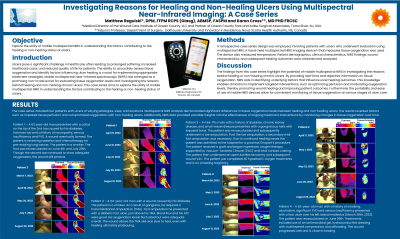Case Series/Study
(CS-121) Investigating Reasons for Healing and Non-Healing Ulcers Using Multispectral Near-Infrared Spectroscopy: A Case Series

Karen Cross, MD, PhD, FRCSC – Adjunct Professor, Department of Surgery, Dalhousie University
Introduction: Ulcers pose a significant challenge in healthcare, often leading to prolonged suffering, increased healthcare costs, and reduced quality of life for patients. The ability to accurately assess tissue oxygenation and identify factors influencing ulcer healing is crucial for implementing appropriate treatment strategies. Mobile multispectral near-infrared spectroscopy (NIRS) has emerged as a promising non-invasive tool for evaluating tissue oxygenation levels and investigating the reasons behind healing and non-healing chronic ulcers. This case series aims to explore the utility of mobile multispectral NIRS in understanding the factors contributing to the healing or non-healing status of ulcers.
Methods: A retrospective case series design was employed, involving patients with ulcers who underwent evaluation using multispectral NIRS. A hand-held multispectral NIRS imaging device* that measures tissue oxygenation was used. The device also measured temperature. Patient demographics, clinical characteristics, NIRS findings, wound characteristics, and subsequent healing outcomes were collected and analyzed.
Results: The case series included four patients with ulcers of varying etiologies, sizes, and durations. Multispectral NIRS analysis demonstrated significant differences in tissue oxygenation levels between healing and non-healing ulcers. The results revealed factors such as impaired tissue perfusion and compromised oxygenation with non-healing ulcers. Additionally, NIRS data provided valuable insights into the effectiveness of ongoing treatment interventions by monitoring changes in tissue oxygenation over time.
Discussion: The findings from this case series highlight the potential of mobile multispectral NIRS in investigating the reasons behind healing or non-healing chronic ulcers. By providing real-time and objective information on tissue oxygenation, NIRS aids in identifying underlying factors that influence ulcer healing outcomes. This knowledge enables clinicians to implement targeted interventions, such as optimizing perfusion and modulating oxygenation levels, thereby promoting wound healing and improving patient outcomes. Furthermore, the portability and ease of use of mobile NIRS devices allow for convenient monitoring of tissue oxygenation at various stages of ulcer care.
Trademarked Items:
References:
Methods: A retrospective case series design was employed, involving patients with ulcers who underwent evaluation using multispectral NIRS. A hand-held multispectral NIRS imaging device* that measures tissue oxygenation was used. The device also measured temperature. Patient demographics, clinical characteristics, NIRS findings, wound characteristics, and subsequent healing outcomes were collected and analyzed.
Results: The case series included four patients with ulcers of varying etiologies, sizes, and durations. Multispectral NIRS analysis demonstrated significant differences in tissue oxygenation levels between healing and non-healing ulcers. The results revealed factors such as impaired tissue perfusion and compromised oxygenation with non-healing ulcers. Additionally, NIRS data provided valuable insights into the effectiveness of ongoing treatment interventions by monitoring changes in tissue oxygenation over time.
Discussion: The findings from this case series highlight the potential of mobile multispectral NIRS in investigating the reasons behind healing or non-healing chronic ulcers. By providing real-time and objective information on tissue oxygenation, NIRS aids in identifying underlying factors that influence ulcer healing outcomes. This knowledge enables clinicians to implement targeted interventions, such as optimizing perfusion and modulating oxygenation levels, thereby promoting wound healing and improving patient outcomes. Furthermore, the portability and ease of use of mobile NIRS devices allow for convenient monitoring of tissue oxygenation at various stages of ulcer care.
Trademarked Items:
References:

.png)